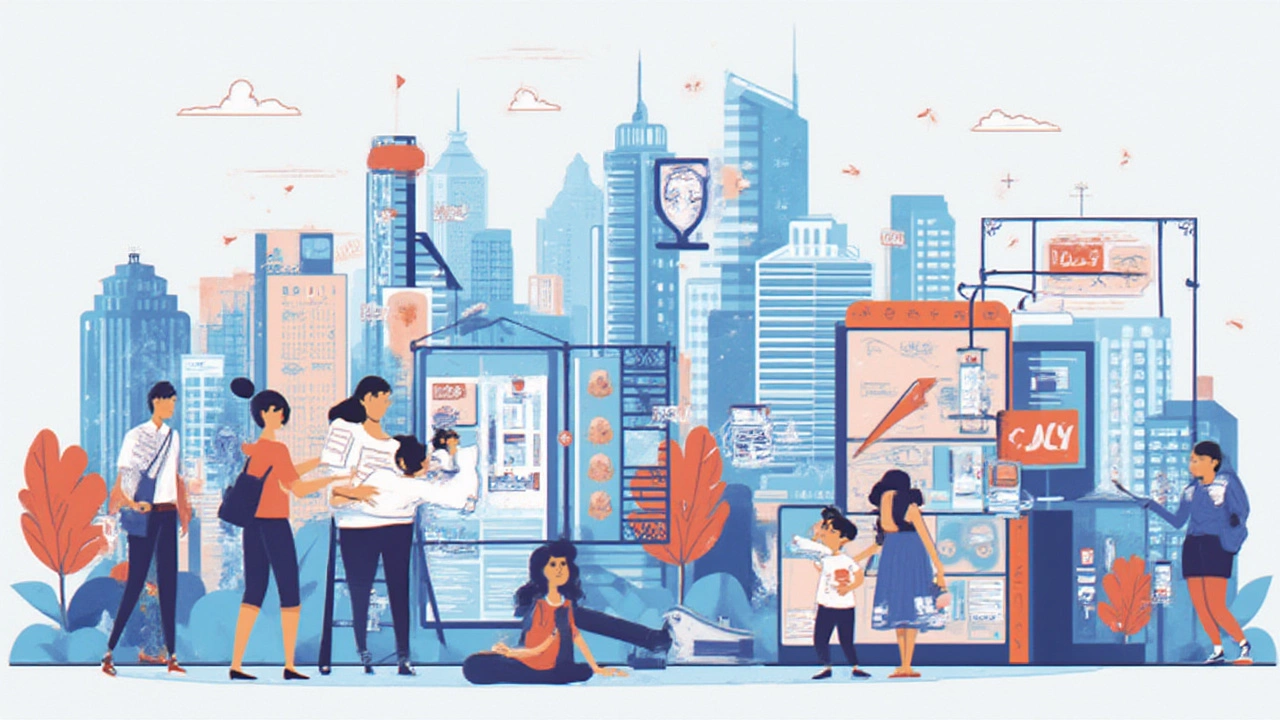Austin TX Rent Guide: Costs, Trends, and Moving Tips

Jul, 29 2025
Ever tried finding an apartment in Austin and felt like you were chasing a unicorn? The rent in Austin, TX has become the stuff of both legend and late-night anxiety. Back in the early 2010s, people used to joke that you could land a two-bedroom for less than a bike at Mellow Johnny’s. Fast forward to July 2025, and everyone wants answers: Where did the affordable Austin go? And what’s the real story behind skyrocketing rent?
Austin’s Rental Prices: What You’ll Really Pay in 2025
Austin is not just a college town anymore—it’s one of the hottest places for tech workers, creatives, and pretty much anyone chasing sunshine and a unique city vibe. Rent isn’t what it used to be. As of this year, the average rent for a one-bedroom apartment sits right around $1,705, while a two-bedroom comes in at about $2,170. South Congress, once “quirky affordable,” now rivals spots like Domain Northside for those Austin rents that make you do a double-take.
It’s easy to see why prices have jumped. Between 2021 and 2023, Austin had more than 180 people moving in every day. That pushed vacancy rates well below 8%, which is lower than most other big Texas cities. Curious what’s behind it? Huge companies like Tesla and Apple set up campuses, making jobs plentiful and housing scarcer. Downtown, Rainey Street, and even the old East Side have shifted from funky and affordable to “wow, is that really my rent?”
If you comb through listings today, Lower East side is averaging $2,250 for a two-bedroom apartment. Hyde Park, beloved by students for decades, now sits above $1,600 for a junior one-bedroom—often with no parking included. Outside central Austin, places like Pflugerville and Round Rock are cheaper but, even there, most single units go above $1,400. And let’s not even start with rental homes—the average house in central Austin rents for north of $2,800 a month.
If you’ve got pets, expect to pay up: most buildings add $25–$50 per month per animal, not including a pet deposit that can run as high as $500. Parking is often extra too, especially in the core. If you want a garage or reserved spot, add another $80–$200 each month. Utility costs? Water, trash, and pest control typically get bundled at $60–$100 monthly, separate from electric, which is still under $100 in most efficient one-bedrooms—unless the summer heat demands constant AC, and then all bets are off.
One sneaky thing: advertised rents usually list their lowest available units. Actual rent can be 5–15% more, depending on demand when you sign a lease. The lesson? Don’t trust the billboard or the big banner on the leasing office—ask what’s open, and ask about fees.
Where Are Rent Prices Headed Next?
So, is Austin rent going to calm down? Not so fast. The pipeline for new apartment complexes is hot, but not keeping up with demand. In 2024, just over 10,000 units opened citywide. More buildings are set to finish in the next two years, especially near Riverside and Parmer Lane. But Austin’s population keeps growing faster than developers can pour new foundations.
Housing experts from the University of Texas said last month that as long as job growth stays above 3% per year—and it has—rents aren’t coming down much. The city did see a brief slow-down in late 2023, when remote work let people try smaller cities, but it didn’t last. By spring 2024, nearly every new building in East Austin and Midtown was filled again.
Some renters are banking on new incentives. A handful of complexes offer one or two months free if you move in right now, but the effective monthly rent still sits within $50 of the typical Austin median. Thanks to historic lows in vacancy rates and a packed events calendar (SXSW, F1, ACL—all back in full swing post-pandemic), landlords are in the driver’s seat. Good deals come and go fast, especially around move-in season for the University of Texas, which churns up the market every August. Fall leasing? It’s an Olympic sport in this town.
Looking for trends? Tech company layoffs in early 2024 scared some landlords, but didn’t dent prices. Interest rates on mortgages stayed high for another year, keeping would-be homebuyers renting longer. That’s kept the rental market tight and prices stubbornly high. One big change: more co-living listings are popping up, especially in neighborhoods near Zilker and Mueller. It’s not unusual for three young professionals to share a modern house and still each pay close to $1,200 a month—the price of a decent one-bedroom in 2021.

Neighborhood Breakdown: Finding a Spot That Fits Your Budget
Your rent in Austin really comes down to where you plant your flag. Not all neighborhoods hit your wallet the same. If you want that Barton Springs lifestyle—walking distance to paddle boarding, Zilker concerts, and food trucks—you’ll pay more. South Lamar, known for its blend of old-school apartments and sleek new mid-rises, runs about $1,700 for a one-bedroom. Meanwhile, North Austin communities like Wells Branch, with decent commutes to both tech jobs and downtown nightlife, hover around $1,450 for comparable space.
Head east, and things get interesting. East Austin, long called the city’s creative heart, has seen a surge of development. Murals and taco spots? Still there. Rent relief? Not so much. You’re looking at over $1,800 for a modern one-bedroom near Boggy Creek. Some historic duplexes still trade cheaper, but updates, security deposits, and older plumbing can cut into savings.
Crestview and Anderson Lane attract families and professionals who want quieter streets but still love a five-minute scooter ride to breweries or coffee shops. Expect one-bedrooms around $1,575 and two-bedrooms for $2,050. Farther out, spots like Westlake and Lake Travis cater to bigger budgets, with luxury rentals north of $3,000 per month.
If you’re chasing value, look at places like Riverside or Tech Ridge. These neighborhoods have more apartments geared toward students and first-time renters. You might find specials, like getting the first month free or a discounted pet deposit, especially in big complexes with over 200 units. Just read the fine print—some deals expire fast or only apply to top-floor, farthest-out units.
Don’t ignore suburbs if you’re okay with a commute. Pflugerville, Cedar Park, and Manor have grown into mini-cities with their own nightlife, hike-and-bike trails, and apartment villages. One-bedroom rents here still slide under $1,400 in older properties. But as Tesla expands in the southeast, expect those numbers to tick higher in the next year or two.
What Drives Austin’s Rent? Tech, Trends, and Real People
Wondering why everyone’s sticker shocked? Austin’s story is about more than the weather or tacos. The city’s wild rent climbs start with tech. Ten years ago, folks thought of Austin as a music town with a few startups sprinkled in. Now? Major companies have set up huge offices (Apple’s expanded North Austin campus alone covers 133 acres). Add the Tesla Gigafactory, Google’s high-rise, and Meta’s regional hub, and suddenly six-figure tech salaries are shifting local prices in a big way.
But tech isn’t the only culprit. Austin has always been magnetic for students, creatives, and out-of-state dreamers. That means house-hunting season never really ends—and landlords can set rent higher when demand never drops. Landlords say business is booming, and local property managers regularly report waitlists of 100+ for popular layouts in student-heavy zones.
Short-term rentals like Airbnb keep some units off the long-term market, especially downtown and near Lady Bird Lake. Regulations have gotten tighter, but landlords still see higher profits from travelers, especially during music or festival season. When Formula 1 or South by Southwest rolls around, regular tenants sometimes get outbid by weeklong guests.
The city’s efforts to expand affordable housing are visible but still not enough to offset the sheer pace of migration. Two recently completed city-led communities in East Austin filled up within days. Plus, skyrocketing property taxes are nudging landlords to pass costs onto tenants. Renters in single-family homes or smaller buildings feel this crunch most—there’s little you can do to negotiate when the only alternative is another $400 per month across town.
Is rent control coming? Unlikely. Texas state law limits how much cities can regulate rent hikes. Advocacy groups are pushing for more tenant protections and streamlined application fees, but changes are slow. Meanwhile, renters keep hunting for loopholes—finding friends to split a big house, jumping on a listing the minute it appears, or sweet-talking smaller landlords into flexible terms.

Tips for Renters: How to Survive (and Maybe Even Win) in Austin Right Now
Rent shopping in Austin can feel like a game of Whac-A-Mole, but you don’t need to give up (or get priced out). If you want to snag the best deals, timing is everything. Most leases start and end in late summer, when the University of Texas turns over thousands of student apartments. Looking for a place in May or June is sometimes less competitive than mid-July, when everyone else is scrambling.
When you tour, ask for all hidden costs upfront—parking, pet fees, utility bundling, and trash service can sneak $100–$300 onto your total monthly payment. Also, check which internet providers are available; some new luxury buildings only allow certain companies, and that can add hassle (and cost) if you work from home.
If your budget’s tight, consider a roommate. More locals are turning to online groups like Facebook or Nextdoor to find roommates, often landing in bigger three- or four-bedroom homes at prices way better than solo apartment living. Don’t be surprised if you see listings for “co-living” spaces, where you get a private room but share kitchens and living areas. These can save money and often come furnished, which is handy for newcomers.
Scams are out there, especially on popular listing apps. Never send money before seeing a place—and look out for landlords who want deposits via Zelle or Venmo before showing you the property. Stick to reputable brokers or local property managers if you’re new in town. Sometimes, smaller landlords will drop rents if you commit to a longer lease—15 or 18 months instead of 12. Always ask if that’s an option.
Got a pet? The best apartments allow them, but fees stack up. Some buildings even have breed or weight restrictions. Call ahead so you don’t waste time—especially if you’ve got a dog over 50 pounds.
Want to avoid traffic? Look for places right by a Metro Rapid bus stop or close to the new Orange Line, which started construction in early 2024. Austin’s public transit is no New York subway, but hopping a bus or bike share can save big on parking and cut down commute headaches.
The rental hunt in Austin is never boring—but with a little hustle, a watchful eye, and maybe some new roommates, you can still claim your own slice of the 512. Know your budget, Austin rent averages, and always move fast when you see something good. That’s the real key to not just surviving, but thriving, under the big, blue Texas sky.